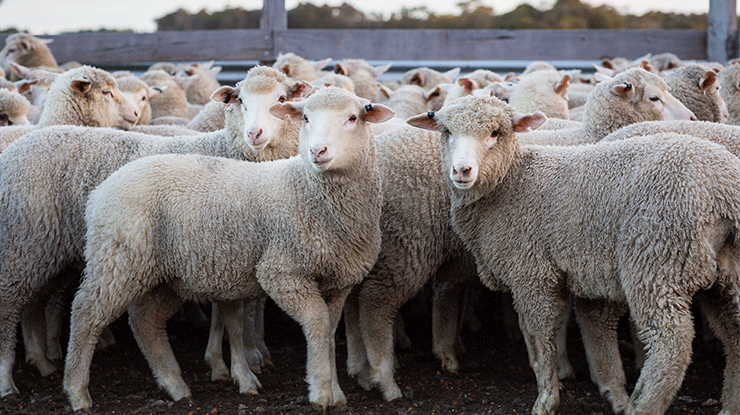 The provision of pain relief for sheep husbandry procedures such as mulesing, tail docking and castration is an expectation for industry.
The provision of pain relief for sheep husbandry procedures such as mulesing, tail docking and castration is an expectation for industry.
What you need to know for best practice pain relief
Changing consumer and community expectations mean the use of pain relief while conducting routine livestock husbandry practices is becoming essential to ensure the sustainability of the industry.
While pain relief should always be applied where painful procedures are undertaken, a sustainable industry hinges as much on the pursuit of alternative, non‑aversive husbandry techniques as it does on pain relief.
Check out the three pain relief factsheets here:
- Pain mitigation for castration in beef cattle in southern Australia
- Pain mitigation in sheep and cattle
- Pain mitigation in sheep
Here’s a look at some of the best practice strategies for pain relief.
The best pain relief medicine for the job
Registered medicines for pain relief in sheep and cattle are either local anaesthetics or non‑steroidal anti‑inflammatory drugs (NSAIDs).
Local anaesthetics intend to provide immediate relief for an animal, whereas NSAIDs are used for longer‑term relief as analgesics.
These medicines can be administered topically, by injection, or by buccal administration applied through the cheek or mouth lining, which allows absorption into the bloodstream without the need for swallowing.
Depending on the husbandry procedure in question, different applications will be required.
Currently, it’s recommended producers use a combination of local anaesthetics and NSAIDs, ideally before the surgical husbandry procedure is done, to achieve the broader spectrum and longer duration of a multi‑modal analgesic approach when undertaking painful animal husbandry procedures.
Where the creation of open wounds is unavoidable, topically applied analgesics can be administered on the affected area immediately after the creation of these wounds. This applies to both sheep and cattle.
Alternative practices for sheep
The provision of pain relief for sheep husbandry procedures such as mulesing, tail docking and castration is increasingly an expectation for industry – pain relief for mulesing is mandated in Victoria.
It’s important for producers to understand the best practice methods for providing pain relief, and whether they can adopt alternative practices to remove the need for these husbandry procedures in the future.
In many instances, animal husbandry procedures are crucial for the survivability and long‑term wellbeing of a flock or herd.
However, producers should regularly assess this need and whether alternative measures can be carried out. For example, plainer breeches can be selected for Merino sheep within breeding decisions, in combination with optimal shearing time and additional crutching, to remove the need for mulesing.
These alternatives not only ensure a greater level of animal welfare and community trust, but align with Sheep Producers Australia (SPA) policy that prime lambs should not come from mulesed dams, helping producers meet industry standards.
Pain relief for sheep
Where alternatives are unavailable (or have not had time to take effect, such as breeding plainer breeched sheep) and husbandry procedures need to be carried out, producers should always follow recommendations provided on the registered animal medicines used.
Where possible, husbandry procedures should also minimise the creation of open wounds, such as through using elastrator rings instead of knife castration and when tail docking.
No matter the methods used for tail docking, castration and other activities, a combination of anaesthetics and analgesics (NSAIDs) is recommended for the greatest pain relief results.
Pain relief for cattle
Castration is a routine procedure in most southern and many northern beef herds, due to the age of turn‑off of steers, issues around safe handling and animal management, effects on eating quality, and the unacceptable welfare implications of incidental pregnancies in female cattle presented for processing or live export.
Dehorning is also carried out routinely on animals with horns and scurs as a means of improving animal welfare and workplace safety.
Pain relief should be used for both practices.
Alternate husbandry practices
There’s currently no established alternative pathway for leaving male animals unsterilised in Australian beef production systems. However, producers should always consider the need for all husbandry procedures, and ensure they are up‑to‑date with industry regulations and best practice management strategies.
Polled gene selection is an important step for the industry to cease the painful practice of dehorning cattle (currently 73% of registered Australian cattle are polled, according to the Australian Beef Sustainability Framework).
Introducing polled genetics into herds will decrease dehorning and improve the overall welfare of the herd.
Pain relief for cattle husbandry
While there’s insufficient research to suggest the best form of pain relief for castration and dehorning, a combination of both local anaesthetics and NSAIDs should achieve the highest level of pain mitigation.



